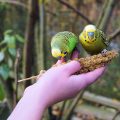Table of Contents
How to care for budgie birds? A budgie bird is one of the most popular pets to keep today, ranking just behind common household pets like cats and dogs. Budgies or budgerigars are cute and affectionate birds that are low – maintenance. When it comes to how to care for budgie birds, they are relatively inexpensive and easy to keep for the most part. In this article, you’ll learn facts and some tips on how to care for budgie birds.
How to Care for Budgie Birds: Size and Appearance
How to care for budgie birds? One of the things that make budgies interesting is that you can train them to mimic human speech. However, keeping a budgie aren’t all fun and games but they are definitely charming pets to keep and they are ideal as a first pet.
Before you bring a budgie home, here are some things you need to know:
The full name of budgies is budgerigars but some prefer calling them as parakeets. Neither is 100% correct nor exactly wrong. This is because there are various types of parakeets.
Parakeets come in different sizes, shapes and colors. There are some species like the Indian Ringneck Parakeet that is relatively larger compared to the rest of the species.
For instance, Indian Ringneck can reach up to sixteen inches from its head up to its tail. Budgies, on the other hand, are way smaller. And because of these huge differences in their sizes, parakeet species are being referred by their true names as it is just more accurate.
How to care for budgies? It’s important to note though that budgies are not the smallest parrots but even for parrotlets, budgies are tinier. Budgie birds have an average length of around 7 to 8 inches from their beaks up to the tip of their tails. Wild budgies that are ranging in Australia, which is their native habitat, are much smaller than captive budgies.
Two Types of Budgies
What a lot of people don’t know is that there are two types of budgie birds. The first one is the traditional budgie that is usually found in Australia. The second one is a relatively larger budgie that is bred in Great Britain. The English budgie is specifically bred for pet trade and showing purposes.
While these two types are both considered as budgie species, there are distinct differences between them especially if you’ve observed them together. For instance, English budgie birds are around 2 inches longer than their Australian kinds. English budgies also have puffier feathers and larger heads. Their crowns and faces also have more feathers in it compared to the Australian budgerigars.
How to care for budgies? People are usually accustomed to seeing colored budgies especially when you happen to pass by a pet store, or even online. However, keep in mind that in the wild, the natural color of a budgie is only two: it comes in yellow and green colors.
Other colored budgies that you often see like the blue budgies, white budgies and the likes are just color mutations that are bred specifically for pet trade purposes. There’s nothing wrong with it, just don’t expect to find a blue – colored budgerigar in the wild because you won’t find one.
Since budgies are small, they are relatively cheap to care for. But contrary to popular belief, a bird’s diet doesn’t just involve seeds. In fact, it’s not healthy for a bird of any kind to just eat seeds. Smaller species like the budgies will definitely have some health issues in the long run. This is why most vet experts recommend that a bird diet should include not only seeds but also leafy veggies, fresh fruits and pellets. Seeds should still be a part of their diet but make sure that your bird will also get enough nutrients from other food source.
Cool Abilities of Budgies
How to care for budgies? When it comes to mimicking human sound, there’s actually no way to guarantee that your pet budgie, or any other type of parrot for this matter, will learn to speak. But usually budgies have a knack for it. They have the natural ability to speak with much greater clarity, and can also learn more vocabularies that your average parrots. They can speak more clearly than Cockatoos and Macaws.
While the voices of budgies are small and usually have that gravelly sound, they do have a cool ability to learn human phrases and words. In fact, they know how to sometimes use it in the proper context. This is why many people who are new to owning birds choose budgies as their first pets because it’s just like owning a talking parrot but perhaps better.
How to Care for Budgies: Budgies as Pets
When it comes to knowing how to care for budgies Budgerigar birds generally respond well to regular handling but make sure that you do it gently. They are affectionate birds and are also tame, making them ideal as pets. In addition to that, even if they mimic human sounds, they are not as loud compared to other parrots.
As mentioned earlier, budgies can learn human language but obviously this will depend on the individual bird, and how much you’re willing to train them. The good thing is that innately, they are already capable of learning words and phrases in different languages!
A bit of a caveat though, even if budgies are quieter compared to other species, they could still be quite noisy and messy at times – something that all birds share. Just like any other pets, keeping budgies is a huge commitment. You don’t just provide for their necessities, you also need to put in the time and effort to train them, spend time with them, and provide them some form of physical and mental stimulation. Providing them with shelter and properly feeding them is just the tip of the iceberg in pet keeping.
Another important thing to keep in mind when it comes to how to care for budgies is that budgie birds are small and timid, and they are definitely considered as preys. If you happen to have other household pets like dogs or cats, make sure that you secure your birds in their cages so that potential predators can’t reach them. Stay tune for more posts about budgies!






 Author and long-time animal lover. Sharing knowledge on pet care through experience and the written word.
Author and long-time animal lover. Sharing knowledge on pet care through experience and the written word.